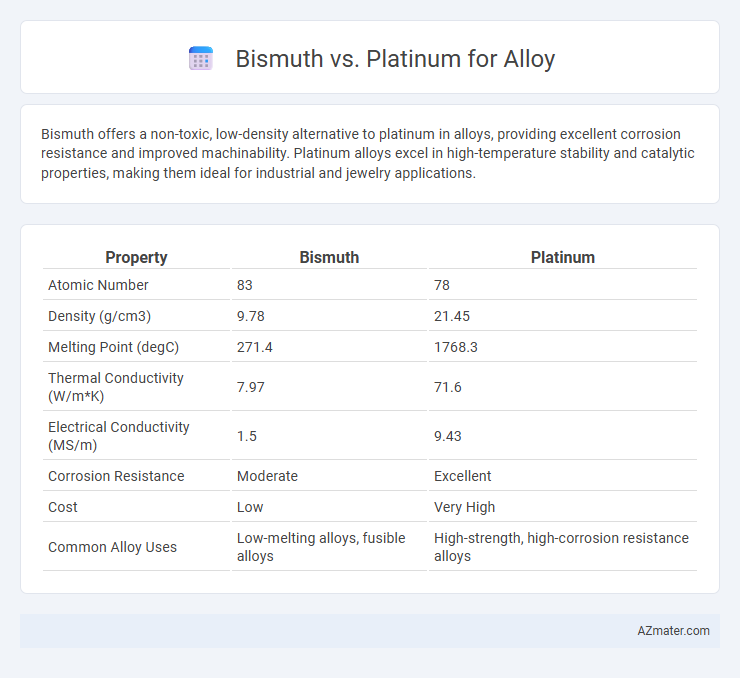Bismuth offers a non-toxic, low-density alternative to platinum in alloys, providing excellent corrosion resistance and improved machinability. Platinum alloys excel in high-temperature stability and catalytic properties, making them ideal for industrial and jewelry applications.
Table of Comparison
| Property | Bismuth | Platinum |
|---|---|---|
| Atomic Number | 83 | 78 |
| Density (g/cm3) | 9.78 | 21.45 |
| Melting Point (degC) | 271.4 | 1768.3 |
| Thermal Conductivity (W/m*K) | 7.97 | 71.6 |
| Electrical Conductivity (MS/m) | 1.5 | 9.43 |
| Corrosion Resistance | Moderate | Excellent |
| Cost | Low | Very High |
| Common Alloy Uses | Low-melting alloys, fusible alloys | High-strength, high-corrosion resistance alloys |
Introduction to Bismuth and Platinum Alloys
Bismuth and platinum alloys serve distinct purposes due to their unique physical and chemical properties, with bismuth known for its low toxicity, high density, and excellent machinability in low-melting alloys. Platinum alloys exhibit exceptional corrosion resistance, high melting points, and superior mechanical strength, making them ideal for high-performance applications such as jewelry and catalytic converters. Comparing their alloy systems highlights bismuth's use in fusible alloys and environmentally friendly applications, whereas platinum alloys excel in durability and resistance in extreme conditions.
Chemical Properties: Bismuth vs Platinum
Bismuth exhibits low chemical reactivity, high density (9.78 g/cm3), and a melting point of 271.5degC, making it useful for low-melting-point alloys and thermoelectric applications. In contrast, platinum is highly resistant to corrosion, has a melting point of 1768.3degC, and exhibits excellent chemical stability and inertness, ideal for catalytic and high-temperature alloy uses. The distinctive oxidation states--bismuth commonly +3 and +5, platinum ranging from 0 to +4--significantly influence their alloying behavior and chemical durability.
Physical Characteristics Comparison
Bismuth exhibits a low melting point of 271.5degC and a high density of 9.78 g/cm3, making it significantly less dense and softer compared to platinum, which has a melting point of 1,768.3degC and a density of 21.45 g/cm3. Platinum offers superior hardness and exceptional corrosion resistance, crucial for durable alloy applications, while bismuth provides brittleness and excellent thermal stability. The distinct thermal conductivity values, with platinum at approximately 71.6 W/m*K and bismuth much lower at 7.97 W/m*K, highlight their differing roles in heat dissipation within alloys.
Alloy Formation Mechanisms
Bismuth and platinum exhibit distinct alloy formation mechanisms due to their differing atomic sizes and electronic configurations, influencing phase stability and solubility. Bismuth typically forms low-melting-point, immiscible alloys with platinum, driven by limited solid solubility and phase separation tendencies, often resulting in composite microstructures. Platinum's strong metallic bonding and higher melting point promote the formation of stable intermetallic compounds in alloys with metals other than bismuth, highlighting the unique thermodynamic interactions in Bi-Pt systems.
Industrial Applications of Bismuth Alloys
Bismuth alloys are valued in industrial applications for their low toxicity, excellent machinability, and expanding use in safety devices, casting, and cooling systems, contrasting with platinum's high cost and limited availability. Bismuth's low melting point and non-toxicity make it ideal for use in fire detection and suppression systems, while platinum alloys are primarily reserved for catalytic converters and high-performance electronics requiring corrosion resistance. Industrial sectors benefit from bismuth alloys in eco-friendly alternatives to lead, especially in plumbing, electrical fuses, and precision casting molds.
Industrial Applications of Platinum Alloys
Platinum alloys are extensively used in industrial applications due to their exceptional corrosion resistance, high melting point, and excellent mechanical strength at elevated temperatures. Industries such as chemical processing, aerospace, and electronics rely on platinum alloys for components like catalysts, electrical contacts, and thermocouples, where durability and performance under harsh conditions are critical. In contrast, bismuth alloys, while useful in specialized low-melting-point applications and non-toxic alternatives, do not match platinum's superior thermal stability and wear resistance required for high-demand industrial environments.
Cost and Availability Analysis
Bismuth offers a significantly lower cost and higher natural abundance compared to platinum, making it a more economical choice for alloy production. Platinum's rarity and complex extraction process drive up its market price, limiting widespread alloy use in cost-sensitive applications. While platinum provides superior corrosion resistance and catalytic properties, bismuth's affordability and easier availability make it a practical alternative for various industrial alloys.
Environmental Impact and Safety
Bismuth offers a significantly lower environmental impact than platinum due to its abundance, non-toxicity, and ease of recycling, making it a safer choice for alloy production. In contrast, platinum mining involves extensive environmental degradation and generates hazardous waste, raising concerns regarding ecological sustainability and worker safety. The non-toxic nature of bismuth alloys reduces health risks in manufacturing and end-use applications, promoting safer industrial practices compared to platinum-based alloys.
Performance in High-Temperature Environments
Bismuth exhibits limited high-temperature stability, softening and oxidizing at temperatures above 270degC, which restricts its performance in high-temperature alloy applications. Platinum maintains exceptional thermal resistance, with melting points above 1700degC and excellent oxidation resistance, making it ideal for high-performance alloys in extreme heat conditions. Alloy compositions leveraging platinum outperform those with bismuth in durability, strength retention, and oxidation resistance at elevated temperatures.
Choosing the Right Metal for Alloy Production
Bismuth offers low toxicity and excellent machinability, making it ideal for eco-friendly alloys, especially in pharmaceuticals and electronics. Platinum excels in corrosion resistance and high melting point, suitable for high-performance, durable alloys in aerospace and catalytic applications. Choosing the right metal depends on balancing cost, mechanical properties, and environmental impact to optimize alloy functionality and sustainability.

Infographic: Bismuth vs Platinum for Alloy
 azmater.com
azmater.com